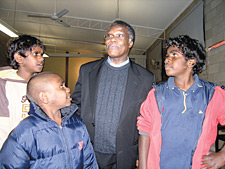A campaign to highlight Aboriginal poverty needs to be well supported.
by Margaret Rodgers
 Some time ago I discussed in this column the United Nations Millennium Development Goals and the worldwide campaign to Make Poverty History. To indicate their support people are asked to wear one of the white bands bearing the slogan, particularly on specially designated days. Right round the globe on 25 November last, people wore a white Make Poverty History band.
Some time ago I discussed in this column the United Nations Millennium Development Goals and the worldwide campaign to Make Poverty History. To indicate their support people are asked to wear one of the white bands bearing the slogan, particularly on specially designated days. Right round the globe on 25 November last, people wore a white Make Poverty History band.
At the recent meeting of the Executive Committee of the National Council of Churches I learned of another campaign of a similar kind. Indeed it is one that not only gives a special focus to the Millennium Development Goals, it also brings them right home here to the consciousness of every Australian. This is the campaign of NATSIEC " that is the National Aboriginal and Torres Strait Islander Ecumenical Council " to persuade all Australians to participate in and support the Make Indigenous Poverty History campaign.
NATSIEC launched this move last month in Parramatta, with former Senator Aden Ridgeway among the indigenous people present. Anglicans were represented by the Vice Chair of NATSIEC, Torres Strait Islander, Bishop Saibo Mabo, an Assistant Bishop in the Diocese of North Queensland.
NATSIEC stresses the campaign aims to ensure that the global campaign supporting the Millennium Development Goals does not overlook the poverty suffered by Indigenous peoples around the world including here in Australia.
In their present form, the MDGs don't specifically target indigenous peoples. Yet they are often the ones most affected by extreme poverty, and they usually rank at the bottom of most social and economic indicators in their nation.
Indigenous children are twice as likely to die in infancy, and indigenous Australians suffer from more preventable diseases, higher unemployment, lower house ownership, and lower engagement with education than other Australians. They are also six times more likely to be murdered. Poverty is a very real and debilitating experience for many indigenous Australians.
Reports prepared for the Council of Australian Governments by the Productivity Commission outline the situation of our indigenous people. While there have been some improvements noticed in economic and social indicators, many of the indicators show little or no improvement. The life expectancy of indigenous people is estimated to be around 17 years lower than that for the rest of the population. In 2004, indigenous students were half as likely to continue to year 12 as non-indigenous students. Suicide rates are much higher for indigenous people than other people.
In the 2001 Census, 410,000 people identified themselves as Indigenous out of a population of nearly 19 million. It is sometimes curiously easy for Australians to overlook the situation of our Indigenous people, for many people have very little experience of and contact with Aboriginal or Torres Strait people.
Graeme Mundine, Executive Secretary of NATSIEC said recently "We will not tolerate the poverty that the poorest of our society currently live in. We will do whatever it takes to ensure that the Indigenous Peoples of Australia have the same opportunities to live as long, to create as much wealth, to see their children grow into healthy and productive adults as non-Indigenous people do.
"We must work as hard for our own poor as we do for those overseas and make indigenous poverty history by 2015."
In Sydney Diocese we have some significant indigenous ministries headed by experienced and committed Aboriginal Christian leaders. We need to support them in every way we can. Affirming the NATSIEC campaign will be one strategic way to assist.
You can get a red, black and white arm band from NATSIEC on 02 9299 2215.























